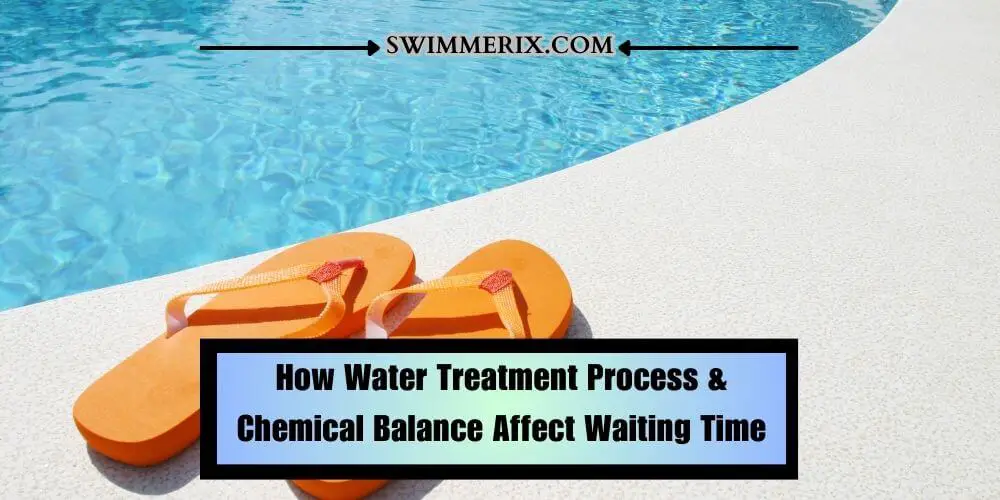
One of the exciting prospects during hot summer days is swimming in a newly filled pool. Hence it is common to wonder, ‘How soon can you swim in a newly filled pool.’ It would help if you considered your safety before taking that lunge.
In this article, I will help you explore the factor that may determine the time required before swimming in a newly filled pool. I will also help you discuss & learn the water treatment process, the time required for pool water stabilization, and other factors that may affect their swimming readiness in the pool.
Also, we will be providing some recommendations that ensure pool safety. But before I tell you all these things, let’s first find out ‘how soon you can swim in a newly filled pool.’
How Soon Can You Swim in a Newly Filled Pool?

How soon you can swim in a newly failed pool depends upon sectors like the type of water treatment you used and specific chemicals added during the initial day. If you use chlorine, wait until its level reaches a safe range before swimming.
In a saltwater pool, you will need to wait around 24-48 hours for the salt to dissolve & ensure it’s in the correct range before swimming. On the other hand, if you use alternative sanitation systems like ozone, UV, or mineral-based treatment, the waiting time may vary. To learn in-depth, below I am mentioning some general guidelines.
Chlorine-Treated Pools
As expected, if you use chlorine as a primary sanitizer, you should wait until the chlorine level reaches a safe range before swimming. This can take anywhere from a few hours to a few days depending on the initial chlorine level & the size of your pool.
I recommend that you test your water using a pool water testing kit to ensure the chlorine level is within the propagate range before swimming for a safe & enjoyable experience. Usually, the chlorine level should be around 1-3 parts per million.
Saltwater Pools
Generally, the saltwater school contains chlorine generated through a salt chlorinate. Therefore, if you have added an appropriate amount of salt to the pool, you should wait at least 24-48 hours for the salt to dissolve & the chlorine levels to stabilize.
Also, check the salt level using a saltwater test kit to ensure they are in the correct range before swimming to prevent itching or irritation.
Note: If you’re unable to know which pool type you’re looking at, consider reading my guide on “How to Tell If a Pool Is Saltwater or Chlorine“
Non-Chlorine Sanitizers
Sometimes, people like to use alternative sanitation systems like ozone UVz or mineral-based treatment, which makes the waiting time vary. Therefore I suggest you follow the manufacturer introductions for your specific product.
This kind of system requires less time than traditional chlorine-based treatment. But you must still verify the water is properly balanced and safe for the swimming experience.
3 Factors Affecting Swimming Readiness
Also, you should note that the time required before swimming in a newly filled pool can also be influenced by some external factors like size & depth of the food as well as climate & weather conditions. Let’s find out more about them in Death.
Size & Depth of the Pool
Depending upon the depth & size of your pool, the time needed for water stabilization will get impacted. You should know that larger pools require more time for the chemical to distribute evenly.
Also, deep pools will have many variations in chemical concentration due to the difference in water movement. Water in smaller pool experiences faster chemical distribution & mixing than larger ones. Also, you should note that deep pools may require additional time for proper chemical distribution & mixing.
Climate & Weather Conditions
Research published in the Pennsylvania State University suggests that weather conditions like high temperature or low humidity will accelerate the evaporation rate, also potentially prolonging the time needed for water stabilization.
YES, climate and water conditions are crucial in the time required before swimming in a newly filled pool. Extreme water temperature, heavy rainfall & strong winds affect water stabilization. I advise you to monitor water weather forecasts and adjust the waiting period to achieve full water readiness for swimming.
Water Source & its Initial Quality
Also, the initial quality of the water source that you used to fill the water will impact the water stabilization. Depending on the source, water may contain additional minerals, contaminants, or impurities that may be required to be addressed before swimming.
I will advise you to also test the water source before feeling into the pool to identify potential issues. You should consider water treatments like shock treatment, filtration, or using specialized chemicals to improve its quality if required. If you’re wondering “Can I Put Iron Out in My Pool“
How Water Treatment Process & Chemical Balance Affect Waiting Time

Chlorination & its Role in Pool Water Treatment
Chlorine is a very important chemical that plays a vital role in disinfecting the water and preventing the growth of bacteria & algae. The Centre for disease control & Prevention emphasizes that the ideal chlorine level for a spacious swimming environment should be around 1-3 parts per million.
Therefore, make sure to regularly test & adjust the chlorine level to maintain that range. Also, another study conducted by the National swimming pool foundation found that improper chlorine levels in pools further lead to waterborne diseases like diarrhea and respiratory issues. And it would help if you used chlorine-based disinfectant & follow the recommended guidelines for maintaining proper chlorine levels to prevent airborne disease.
pH Balance & its Impact on Pool Water Quality
Not only is it important that you maintain the chlorine level, but maintaining the proper pH balance is equally important for the overall quality of pool water & its clarity. It is recommended to keep the ph range around 7.2-7.8. Here, you can learn How to Raise pH Without Raising Alkalinity.
A study published in the journal of environmental health science & Engineering highlighted that improper pH levels can cause eye & skin irritation while reducing chlorine’s effectiveness. Therefore regular testing and adjustment of pH levels are becoming more necessary as a part of necessary maintenance to ensure a comfortable & safe swimming experience.
If you are looking to measure the pH level, you can find various types of test stripes as well as digital meters. However, if the pH is high or outside the recommended range, consider using a pH reducer or pH increasers to return it to the desired levels. However, you might find Pool Cloudy After Ph Increaser which should go away on its own within few hours,
Filtration System & its Role in Maintaining Clean Water
In addition to the chlorination and pH balance, it is important that you also have a properly functioning filtration system to maintain a clean pool. The filtration process is important for removing debris, small particles, & contaminants from the water.
According to the Crystal Falls Pools, the filtration system should run for at least 8 to 12 hours a day or continuously to ensure adequate circulation & filtration. Also, please pay attention to the regular maintenance of the filter, including cleaning or backwashing, to optimize its effectiveness.
Time Required for Pool Water Stabilization
In addition to the water treatment, you should note that pool water may require a certain amount of time to stabilize after filling. Consider the factors below that may influence the stabilization process and the time required for readiness to swim.
Evaporation & Temperature Impact
There is nothing much you can do because evaporation is a natural process where the water is exposed to the air. However, the evaporation rate depends on temperature, humidity, and wind speed.
According to research conducted by the Carleton College, water evaporates more quickly in warmer temperatures or places with a hot and dry, windier climate.
You should note that evaporation can decrease the water level in a newly filled pool by about 1/4 inch per day. Therefore, I recommend you cover the pool when you are not using it to minimize evaporation, as this is more effective than any other method.
Water Circulation & its Effects on Stabilization
Water circulation and water evaporation play a significant role in stabilizing pool water. It helps distribute the chemical evenly, prevents stagnant areas, and ensures proper filtration.
According to experts, you should keep the pool running & circulating the water for at least 24-48 hours before swimming or diving. This duration will further help the chemical to mix thoroughly & achieve a consistent balance throughout the pool area.
Related Topic: Should You Filter or Recirculate Pool When Shocking
3 Recommendations for Ensuring Pool Safety
Regular Testing & Maintenance
You must pay attention to the regular testing of the pool water and maintain the proper chemical balance for a safe & enjoyable swimming environment. Many kinds of test kits are available at most poor supply stores to measure chlorine levels, PH & other chemical parameters. Ensure that you perform regular maintenance tasks like cleaning the filter & backwashing it, or skimming debris, offering better pool hygiene.
Utilizing Pool Covers & Shade Structures
If you are not using the pool, consider using pool covers to reduce evaporation and heat absorption. There are many types of shade structures that you can install, like umbrellas or pergolas, to provide relief from direct sunlight and help maintain the water temperature stable when the pool is not in use. But if you’re worried about how you can run pump, check this post: Can You Run the Pool Pump with a Solar Cover On.
Consulting with Pool Professionals
Suppose you need more confidence about the proper maintenance & safety measures for your pool. In that case, I will advise you to consult with a pool professional or local pool expert who can provide tailored advice to your specific pool setup & local regulation.
Conclusion
I hope you know ‘how soon you can send in a newly filled pool.’ You must consider your safety and the water quality for a safe swimming experience in a newly filled pool during hot & dry climates.
I have given my best to give you a proper understanding of the water treatment process, the importance of allowing sufficient water stabilization time and considering external factors to create a safe swimming environment for you and your loved ones.
Pay attention to your pool’s regular tests and maintenance to ensure ongoing safety & enjoyment. When it comes to swimming in a newly filled pool, proper preparation & patience become key.
I have done my best to give you proper in-depth knowledge on the question of ‘how soon can you swim in a newly filled pool.’ If you find this article helpful, then consider sharing it.
Your share will help people learn ‘how soon you can swim in a newly filled pool’ and the importance of allowing sufficient time for water chemicals & parameters stabilization. Do check my other helpful guide on pool maintenance & care. See you in the next post, till then, take care & goodbye.

Hi, This is Josh. I am a former competitive swimmer and current fitness enthusiast.
I created this site to share my love of swimming with the world!
